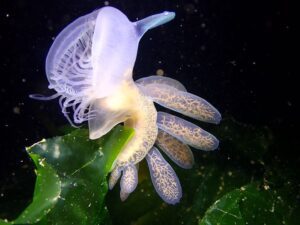The waters surrounding British Columbia host a large variety of marine life. Among these creatures is the mysterious spotted ratfish. This unique fish can be found at depths of up to 900 meters, making it a creature not commonly seen or known about. With a lineage dating back over 400 million years, spotted ratfish are one of BC’s most ancient residents and a true testament to the powers of evolution.

Appearance
The spotted ratfish, also known as Hydrolagus colliei, is made up entirely of cartilage! Belonging to the distinguished Chimaeridae family, referencing the mythical creature that is a composite of other species, this fish shares a kinship with sharks and rays and has physical features reminiscent of other animals. Picture a fish with a sharp, pointed snout like a rodent, a sleek, flattened body like an eel, and a long, slender tail that makes up half its length – that’s our Spotted Ratfish. Let’s not forget to mention its rabbit-like, or even human-like, teeth. The spotted ratfish’s long, tapering, rat-like tail is what gives it its name.

The spotted ratfish can grow up to 3 feet in length. It sports dark, mottled brown skin, bedecked with white spots. It can glide through the water with its broad, wing-like pectoral fins, moving with a grace and elegance likened to flying underwater.
Habitat and Distribution
The spotted ratfish is native to the waters of the North Pacific Ocean, including the coast of British Columbia. The fish can be found at depths of up to 900 metres, where it inhabits soft bottoms and rocky reefs. It is known for its ability to swim up from the deep sea to shallower depths during the nighttime to feed before returning back to the depths during the day.

In addition to the waters surrounding British Columbia, this species can also be found along the coast of Alaska and down to California. It is also commonly found in the Sea of Japan and along the eastern coast of Russia.
Diet and Predators
As bottom-dwellers, spotted ratfish primarily feed on small invertebrates such as crabs, shrimp, and worms. They use their sharp teeth to crush the shells of these creatures before consuming them whole.
Due to its depth preference, the spotted ratfish is not often preyed upon by larger marine animals. However, it has been known to fall victim to other deep-sea predators, such as Pacific halibut and octopuses.

But this ratfish harbours a secret – a venomous mucous-producing organ near its dorsal spine. This mucous is not harmful to humans but can cause irritation and discomfort for potential predators, deterring them from attacking. Seals have been found with fragments of spotted ratfish spine lodged in their organs. However, it’s not known whether this caused the death of the seals.
Reproductive Habits of Spotted Ratfish
The spotted ratfish has a complicated reproductive cycle. It reproduces through internal fertilization. Male spotted ratfish are equipped with two large, forked claspers, which are used to transfer sperm to the females during mating. Interestingly, males also possess a unique head clasper, the purpose of which is not fully understood but is thought to be used in corralling the female during courtship.

After fertilization, females lay strong, keratin-based egg cases. The eggs receive little care or protection from the parents once laid. When the juvenile ratfish hatches, it is fully capable of beginning a predatory lifestyle, preying on various small marine organisms.
Interestingly, spotted ratfish have been observed engaging in “synchronized swimming” during mating season, where multiple males and females swim together in a coordinated manner. This is believed to increase the chances of successful fertilization for the females.
Importance of the Spotted Ratfish and the Threats They Face
Although not a commonly encountered fish, this ratfish plays an important role in the marine ecosystem. The fish preys on small invertebrates, keeping their populations under control.

While not currently considered an endangered species, human activities such as bottom trawling and pollution can have a negative impact on the spotted ratfish population. These fish are also often caught as bycatch in commercial fishing operations.
Conservation efforts like marine protected areas are being made to protect this unique species, but more research is needed to fully understand and protect the spotted ratfish and its habitat.
Conclusion
The spotted ratfish may be an elusive creature, but its importance in the marine ecosystem cannot be underestimated. Its ancient lineage, unique appearance, and role in the marine ecosystem make it a valuable part of our ocean’s biodiversity. Efforts to protect and conserve this species should continue, ensuring that future generations will have the opportunity to marvel at this fascinating fish.



